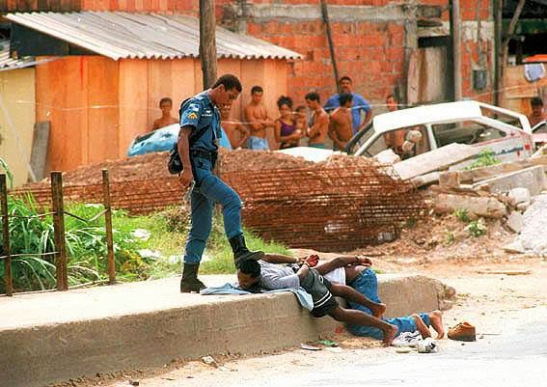Community news. Note from BW of Brazil: As a number of posts on this blog are about the brutality of Brazil’s Military Police, these facts are not actually shocking, including the data about police in two cities killing more people than all police in the entire United States, a fact broken here several months back. But if you’re not familiar with the issue, the report may alert you to huge social problem. Evidence has already shown that this apparent policy of exterminating the poor, black population may have been planned out over thirty years ago which certainly would explain why Brazil sometimes comes off as the “wild, wild west”. Although this piece focuses on the Brazil’s two largest cities, please take note that it is an alarming problem throughout the country. Let this be a warning as to what can happen when your police become militarized.
Seven shocking facts about the police in Brazil that will scare you
Photo by Luiz Morier
In Brazil there is no death penalty, except in cases of declared war, however, we have elaborated on some data that will make you reflect on the role of police in Brazil.
Courtesy of the Folha Social newsroom
In Brazil there is no death penalty, except in cases of declared war, however, we have elaborated on some data that will make you reflect on the role of police in Brazil. It is important to remember that all reported data below are underestimated, since they depend on the cooperation of agencies linked to the state and the police.
1. Police action kills five people per day
Police action kills five people per day in Brazil. The Civil and Military Police of the country killed at least 1,890 people last year, an average of five deaths per day, according to the 7th Anuário de Segurança Pública (Annual Public Safety) report disclosed in São Paulo (SP).
2. Only the Military Police (MP) in Rio and SP only kill more than countries with the death penalty
In 2011, Amnesty International data showed that MP in Rio and SP killed more people than countries with the death penalty. The data show that across the planet 20 countries executed 676 people in 2011, but in Brazil, in only these two states 961 people were killed.
3. Two out of three people killed by the MP, is preta (black) or parda (brown)
Two of every three people killed by military police officers on duty in the city of São Paulo are parda or preta, according to research conducted by DIÁRIO. The proportion is higher than that of negros (pretas + pardas) in the São Paulo population (38%) and also among the state’s imprisoned population (54%).
4. The MP in SP kill more than all US police, despite having a population almost eight times smaller.
Analyzing the rate of deaths per 100 thousand inhabitants, a rate that is usually used to measure criminality and compare crimes in different regions, it appears that in the state of São Paulo, with a population of 41 million, the rate is 5.51. In the US where the population is 313 million, the rate is 0.63. Between 2006 and 2010, 2,262 people were killed after “supostos confronto (supposed confrontations)” with Military Police in São Paulo. In the US, in the same period, according to FBI data, 1,963 were “justifiable homicide”, the equivalent of resistance followed by death recorded in São Paulo.
5. In Brazil, the risk of police dying is three times higher than in other countries
The other side: Research by same agency responsible for the first fact reveals that 23 Military Police officers were killed in 2012 during service and 22 died outside of work. In the Civil Police, the balance was 5 on duty and 8 outside of duty. In other words, the police are killing a lot and also dying a lot. The institution is failing, we are not protecting the police and we are not protecting the population,” said the person responsible for the research.
6. Over 70% of the population does not trust the police
Research conducted by the Fundação Getúlio Vargas (FGV or Getúlio Vargas Foundation) reports that over 70% of the population does not trust the police, superseded only by political parties, which is rejected by 95% of Brazilians. In the United States, 88% of the population trusts their police (1) while in England this figure is 82%.
7. In about ten years in Rio, ten thousand people died or disappeared after alleged confrontations with police.
In 2013 the OAB/RJ (Ordem dos Advogados or Lawyers Guild of Rio de Janeiro) launched the “Desaparecidos da Democracia (Disappeared of Democracy)” campaign, whose results show that more than ten thousand people were killed on suspicion of confrontation with the police in the state of Rio between the years 2001 and 2011 (2). According to the organizer of the campaign, sociologist Michel Misse, Rio state police kill more than many countries. In the United States, where police are known for their brutality, an average of 300 people are killed annually in police confrontation in a population of 313 million (one death for every 1,050,000 people). On the other hand in Rio de Janeiro there are a thousand deaths for 16 million people (one death for every 16,000 people).
Source: Folha Social
Notes
1. While the source of this statistic about the US is not clear, it certainly does not take the racial aspect into consideration. According to recent findings of the Washington Monthly:
“The vast majority of black respondents to our survey—64 percent, compared to only 23 percent of whites—said that you cannot always trust police to do the right thing. Twenty-two percent of black respondents agreed with the statement that ‘the police are out to get people like me.’ Only 4.5 percent of whites felt this way.”
2. For a recent example of disappearance after police confrontation, see the Amarildo case that gained international attention last year.



